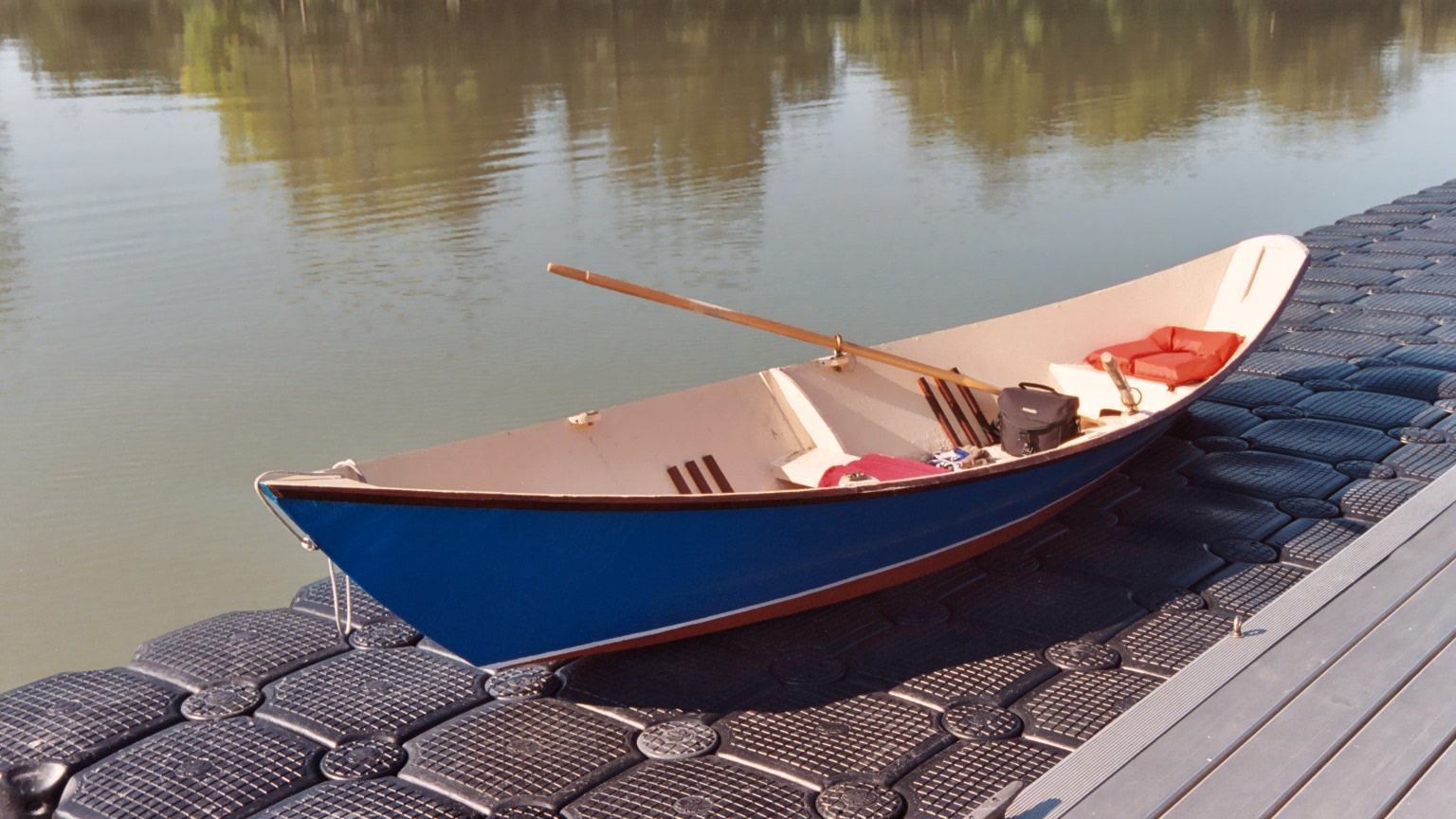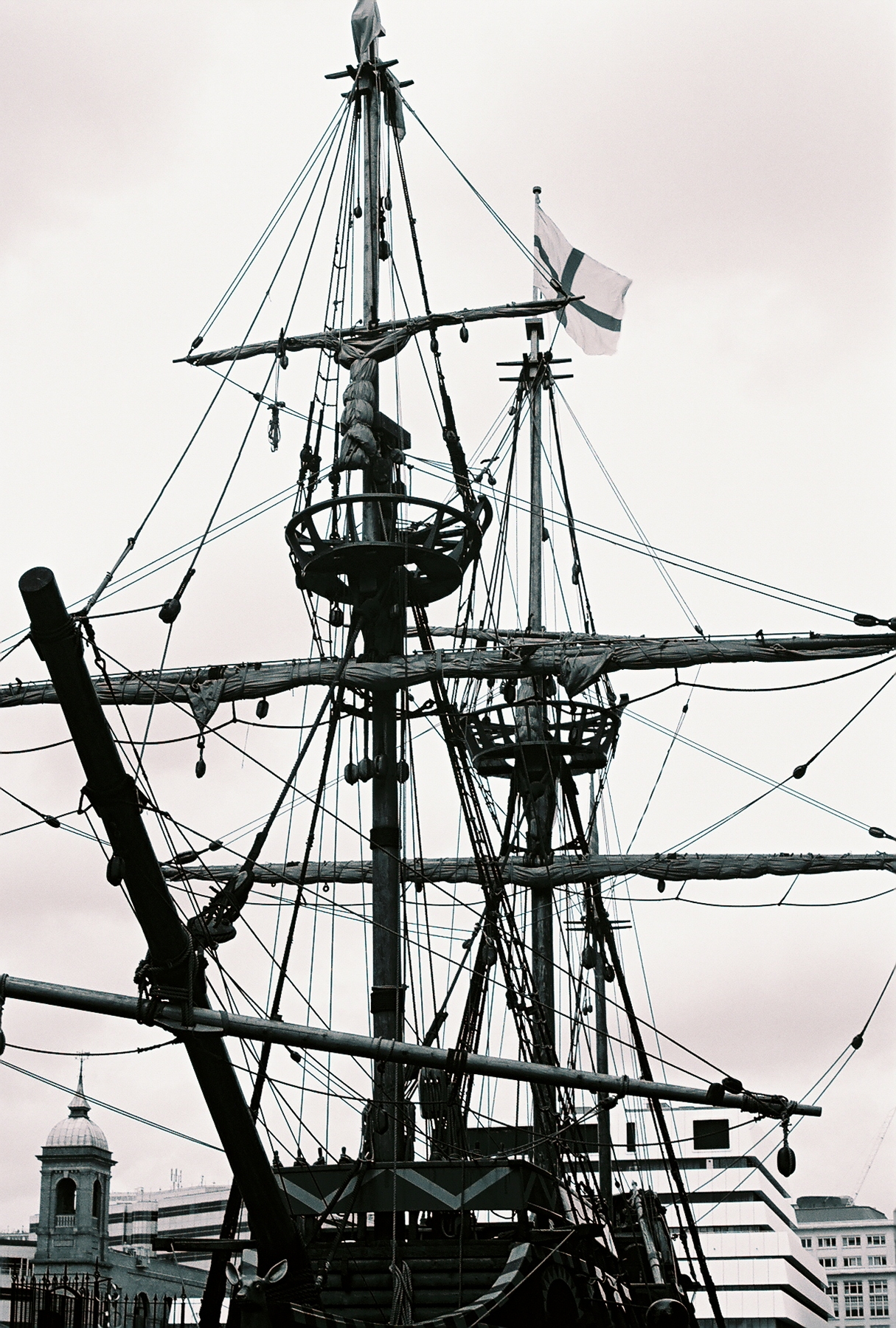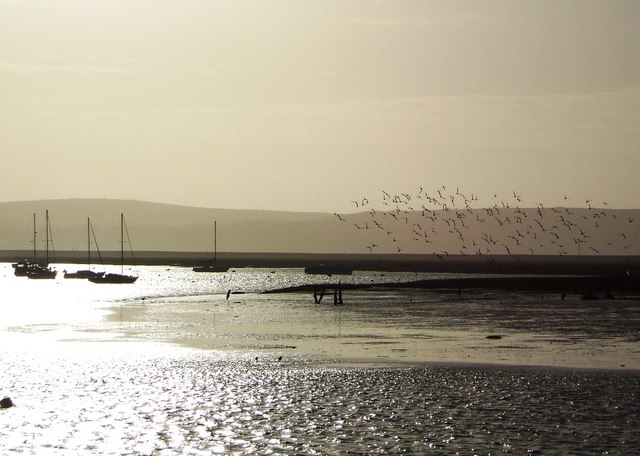|
Scow
A scow is a smaller type of barge. Some scows are rigged as sailing scows. In the 19th and early 20th centuries, scows carried cargo in coastal waters and inland waterways, having an advantage for navigating shallow water or small harbours. Scows were in common use in the American Great Lakes and other parts of the U.S., Canada, southern England, and New Zealand. In modern times their main purpose is for recreation and racing. Scows The name "scow" derives from the Dutch , ultimately from the German for a punt pole and subsequently transferred to mean the boat. Old Saxon has a similar word which means to push from the shore, clearly related to punting. The basic scow was developed as a flat-bottomed barge ( a large punt) capable of navigating shallow rivers and sitting comfortably on the bottom when the tide was out. By 1848 scows were being rigged for sailing using leeboards or sliding keels. They were also used as dumb barges towed by steamers. Dumb scows were used for a ... [...More Info...] [...Related Items...] OR: [Wikipedia] [Google] [Baidu] |
Niagara Scow
The Niagara Scow (also called the Old Scow or Iron Scow) is the unofficial name of the Shipwreck, wreck of a small scow that brought two men perilously close to plunging over the Horseshoe Falls (Canada), Horseshoe Falls, the largest of the Niagara Falls, in 1918. The wreck can still be seen, upstream of the falls. 1918 event On August 6, 1918, Gustave F. Lofberg and Frank Harris were aboard the Great Lakes Dredge and Docks Company scow dredging up sand banks from the Niagara River upstream of the waterfall. When tugboat Captain John Wallace brought the ''Hassayampa'' over to bring the scow back to shore, it broke loose and began floating downriver rapidly towards the falls. There are conflicting reports whether Lofberg and Harris were able to release the false bottom of the scow to dump their load of sand and silt. Regardless, the boat got caught on a shoal, rock shoal from the edge of the falls, leaving the two Niagara Falls Power Company employees stranded in the middle of ... [...More Info...] [...Related Items...] OR: [Wikipedia] [Google] [Baidu] |
Phil Bolger
Philip C. Bolger (December 3, 1927 – May 24, 2009) was a prolific American boat designer, who was born and lived in Gloucester, Massachusetts. He began work full-time as a draftsman for boat designers Lindsay Lord and then John Hacker in the early 1950s. Bolger's first boat design was a 32-foot (9.75 m) sportfisherman published in the January 1952 issue of ''Yachting'' magazine. He subsequently designed more than 668 different boats, from a 114-foot-10-inch (35 m) replica of an eighteenth-century naval warship, the frigate '' Surprise'' (ex-''Rose''), to the 6-foot-5-inch (1.96 m) plywood box-like dinghy Tortoise. Although his designs ranged through the full spectrum of boat types, Bolger tended to favor simplicity over complexity. Many of his hulls are made from sheet materials — typically plywood — and have hard chines. A subclass of these designed in association with Harold Payson called ''Instant Boats'' were so named because they were intended to be easily built b ... [...More Info...] [...Related Items...] OR: [Wikipedia] [Google] [Baidu] |
Barge
Barge nowadays generally refers to a flat-bottomed inland waterway vessel which does not have its own means of mechanical propulsion. The first modern barges were pulled by tugs, but nowadays most are pushed by pusher boats, or other vessels. The term barge has a rich history, and therefore there are many other types of barges. History of the barge Etymology "Barge" is attested from 1300, from Old French ''barge'', from Vulgar Latin ''barga''. The word originally could refer to any small boat; the modern meaning arose around 1480. ''Bark'' "small ship" is attested from 1420, from Old French ''barque'', from Vulgar Latin ''barca'' (400 AD). The more precise meaning of Barque as "three-masted sailing vessel" arose in the 17th century, and often takes the French spelling for disambiguation. Both are probably derived from the Latin ''barica'', from Greek ''baris'' "Egyptian boat", from Coptic ''bari'' "small boat", hieroglyphic Egyptian D58-G29-M17-M17-D21-P1 and similar ''b ... [...More Info...] [...Related Items...] OR: [Wikipedia] [Google] [Baidu] |
Hull (watercraft)
A hull is the watertight body of a ship, boat, or flying boat. The hull may open at the top (such as a dinghy), or it may be fully or partially covered with a deck. Atop the deck may be a deckhouse and other superstructures, such as a funnel, derrick, or mast. The line where the hull meets the water surface is called the waterline. General features There is a wide variety of hull types that are chosen for suitability for different usages, the hull shape being dependent upon the needs of the design. Shapes range from a nearly perfect box in the case of scow barges to a needle-sharp surface of revolution in the case of a racing multihull sailboat. The shape is chosen to strike a balance between cost, hydrostatic considerations (accommodation, load carrying, and stability), hydrodynamics (speed, power requirements, and motion and behavior in a seaway) and special considerations for the ship's role, such as the rounded bow of an icebreaker or the flat bottom of a landing craft. ... [...More Info...] [...Related Items...] OR: [Wikipedia] [Google] [Baidu] |
Leeboard
A leeboard is a form of pivoting keel used by a sailboat largely and very often in lieu of a fixed keel. Typically mounted in pairs on each side of a hull, leeboards function much like a centreboard, allowing shallow-draft craft to ply waters fixed keel boats cannot. Only the leeward side leeboard is used at any time, as it submerges when the boat heels under the force of the wind. A disadvantage, where there is an inadequate fixed keel, is that they typically ship (bear) little ballast, which being on the far side delays the onset of unballasted craft's heeling, that is, to put up a good, constant resistance against the wind. The classical, archetypal definition of ballast is a low, central weight to optimise centre of mass, reduce turning moment and therefore resistance to the boat keeling over, however tends to be higher in self-righting vessels. Modern developments allow them to act as a speed-enhancing lifting foil. History Leeboards existed in China from at least the e ... [...More Info...] [...Related Items...] OR: [Wikipedia] [Google] [Baidu] |
The Adventures Of Tugboat Annie
''The Adventures of Tugboat Annie'' is a 1957 Canadian-filmed comedy television series starring Minerva Urecal as Annie Brennan, the widowed captain of the tugboat "Narcissus," and Walter Sande as Horatio J. Bullwinkle, the captain of the "Salamander." The syndicated series lasted for 39 episodes. Background Norman Reilly Raine's stories of the salty tugboat captain Annie Brennan, a character based on the life of Thea Foss, first appeared in prose form in the weekly US journal '' Saturday Evening Post'' in the late 1920s. She was soon developed into a movie character, depicted in three films and portrayed by a different actress in each ( Marie Dressler in ''Tugboat Annie'', 1933; Marjorie Rambeau in ''Tugboat Annie Sails Again'', 1940; and Jane Darwell in ''Captain Tugboat Annie'', 1945). Development In 1954, a television series was commissioned by the independent American production company TPA. The pilot took two years to complete, at a then-record cost of $129,000. Elsa Lanch ... [...More Info...] [...Related Items...] OR: [Wikipedia] [Google] [Baidu] |
PD Racer
A Puddle Duck Racer or PD Racer is an 8 foot (2.44 m) long, 4 foot (1.22 m) wide, 16 inch (40 cm) high, spec series, racing sailboat. It is a one design hull shape with wide options in other areas. Billed as "the easiest sailboat in the world to build", the scow hull is a simple box, usually built of plywood. PD Racers have a Portsmouth handicap rating of 140.0 and their USSA code is PDR.History of the PD Racer ''PDRacer.com''. Retrieved March 11, 2013. History and scope Designed by David "Shorty" Routh, the PD Racer design was first published and released in 2003, and the first hull was built in January 2004. With a focus on a simple design that uses low cost materials, PD Racers are intended to be accessible to a wide variety of people. All the mat ...[...More Info...] [...Related Items...] OR: [Wikipedia] [Google] [Baidu] |
Schooner
A schooner () is a type of sailing vessel defined by its rig: fore-and-aft rigged on all of two or more masts and, in the case of a two-masted schooner, the foremast generally being shorter than the mainmast. A common variant, the topsail schooner also has a square topsail on the foremast, to which may be added a topgallant. Differing definitions leave uncertain whether the addition of a fore course would make such a vessel a brigantine. Many schooners are gaff-rigged, but other examples include Bermuda rig and the staysail schooner. The origins of schooner rigged vessels is obscure, but there is good evidence of them from the early 17th century in paintings by Dutch marine artists. The name "schooner" first appeared in eastern North America in the early 1700s. The name may be related to a Scots word meaning to skip over water, or to skip stones. The schooner rig was used in vessels with a wide range of purposes. On a fast hull, good ability to windward was useful for priv ... [...More Info...] [...Related Items...] OR: [Wikipedia] [Google] [Baidu] |
Rigging
Rigging comprises the system of ropes, cables and chains, which support a sailing ship or sail boat's masts—''standing rigging'', including shrouds and stays—and which adjust the position of the vessel's sails and spars to which they are attached—the ''running rigging'', including halyards, braces, sheets and vangs. Etymology According to the Encyclopædia Britannica Eleventh Edition "rigging" derives from Anglo-Saxon ''wrigan'' or ''wringing'', "to clothe". The same source points out that "rigging" a sailing vessel refers to putting all the components in place to allow it to function, including the masts, spars, sails and the rigging. Types of rigging Rigging is divided into two classes, ''standing'', which supports the mast (and bowsprit), and ''running'', which controls the orientation of the sails and their degree of reefing. Configurations differ for each type of rigging, between ''fore-and-aft rigged'' vessels and ''square-rigged'' vessels. Standing Standin ... [...More Info...] [...Related Items...] OR: [Wikipedia] [Google] [Baidu] |
Solent
The Solent ( ) is a strait between the Isle of Wight and Great Britain. It is about long and varies in width between , although the Hurst Spit which projects into the Solent narrows the sea crossing between Hurst Castle and Colwell Bay to just over . The Solent is a major shipping lane for passenger, freight and military vessels. It is an important recreational area for water sports, particularly yachting, hosting the Cowes Week sailing event annually. It is sheltered by the Isle of Wight and has a complex tidal pattern, which has benefited Southampton's success as a port, providing a "double high tide" that extends the tidal window during which deep-draught ships can be handled. Portsmouth lies on its shores. Spithead, an area off Gilkicker Point near Gosport, is known as the place where the Royal Navy is traditionally reviewed by the monarch of the day. The area is of great ecological and landscape importance, particularly because of the coastal and estuarine habitats a ... [...More Info...] [...Related Items...] OR: [Wikipedia] [Google] [Baidu] |
Keyhaven
Keyhaven is a hamlet on the south coast of England in the county of Hampshire. It is a fishing village, but the trade has been in decline for a period of years and its main draw now is tourism, especially sailing. Overview Keyhaven lies in the district of the New Forest and is just within the borders of the New Forest National Park. It is in the civil parish of Milford-on-Sea, and it lies at one end of the shingle bank known as Hurst Spit which leads to Hurst Castle. Keyhaven draws visitors through its outstanding natural beauty, from the views over the Solent to the abundance of open farm land. To the east of Keyhaven lies the nature reserve of Keyhaven marshes. History The name "Keyhaven" means ‘Harbour where cows are shipped’; OE cū (genitive cȳ) + hæfen. Cattle and sheep were transported from the Isle of Wight to the water meadows of the Avon around Christchurch. Keyhaven was a port as early as 1206. There seem to have been two manorial estates here, one held by B ... [...More Info...] [...Related Items...] OR: [Wikipedia] [Google] [Baidu] |
Lymington
Lymington is a port town on the west bank of the Lymington River on the Solent, in the New Forest district of Hampshire, England. It faces Yarmouth, Isle of Wight, to which there is a car ferry service operated by Wightlink. It is within the civil parish of Lymington and Pennington. The town has a large tourist industry, based on proximity to the New Forest and its harbour. It is a major yachting centre with three marinas. As of 2015, the parish of Lymington and Pennington had a population of 15,726. History The earliest settlement in the Lymington area was around the Iron Age hill fort known today as Buckland Rings. The hill and ditches of the fort survive, and archaeological excavation of part of the walls was carried out in 1935. The fort has been dated to around the 6th century BC. There is another supposed Iron Age site at nearby Buckland Rings#Ampress Camp, Ampress Hole. However, evidence of later settlement there (as opposed to occupation) is sparse before ''Domesda ... [...More Info...] [...Related Items...] OR: [Wikipedia] [Google] [Baidu] |









